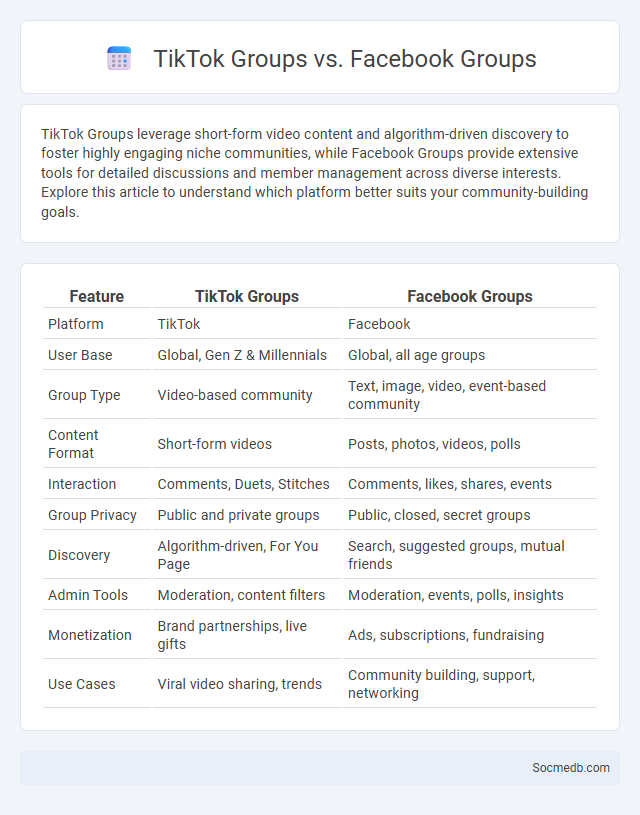
Photo illustration: TikTok Groups vs Facebook Groups
TikTok Groups leverage short-form video content and algorithm-driven discovery to foster highly engaging niche communities, while Facebook Groups provide extensive tools for detailed discussions and member management across diverse interests. Explore this article to understand which platform better suits your community-building goals.
Table of Comparison
| Feature | TikTok Groups | Facebook Groups |
|---|---|---|
| Platform | TikTok | |
| User Base | Global, Gen Z & Millennials | Global, all age groups |
| Group Type | Video-based community | Text, image, video, event-based community |
| Content Format | Short-form videos | Posts, photos, videos, polls |
| Interaction | Comments, Duets, Stitches | Comments, likes, shares, events |
| Group Privacy | Public and private groups | Public, closed, secret groups |
| Discovery | Algorithm-driven, For You Page | Search, suggested groups, mutual friends |
| Admin Tools | Moderation, content filters | Moderation, events, polls, insights |
| Monetization | Brand partnerships, live gifts | Ads, subscriptions, fundraising |
| Use Cases | Viral video sharing, trends | Community building, support, networking |
Introduction to Social Media Groups
Social media groups create interactive communities where users share interests, exchange ideas, and collaborate on topics ranging from hobbies to professional development. These groups enhance your online experience by fostering connections and encouraging active participation in focused discussions. Leveraging the unique features of various platforms can maximize the benefits and reach of your social media group engagement.
What Are TikTok Groups?
TikTok Groups are communities within the TikTok platform that allow users to connect, share content, and engage based on mutual interests or niche topics. These groups foster collaborative content creation, enhance follower interaction, and boost visibility through targeted engagement. By joining TikTok Groups, you can expand your network, stay updated with trends, and grow your presence effectively on the platform.
Understanding Facebook Groups
Facebook Groups offer a powerful platform for creating communities based on shared interests, enabling members to engage through posts, comments, and events. You can leverage these groups to build meaningful connections, promote content, and facilitate targeted discussions that enhance user engagement. Understanding Facebook Groups' privacy settings and moderation tools is essential to fostering a safe and active environment for your audience.
Defining Online Community Building
Online community building on social media involves creating a space where users with shared interests engage, collaborate, and support each other through content sharing, discussions, and interactions. Essential components include fostering trust, encouraging active participation, and maintaining consistent communication to strengthen relationships among members. Effective strategies leverage platform-specific features, such as groups, hashtags, and live events, to enhance connectivity and build a loyal, engaged community.
Key Features: TikTok Groups vs Facebook Groups
TikTok Groups emphasize short-form video sharing, algorithm-driven content discovery, and real-time engagement through polls and challenges, fostering viral trends within communities. Facebook Groups offer diverse content formats including posts, events, files, and live streams, supported by robust moderation tools and detailed privacy settings for deeper community management. Both platforms facilitate social interaction but differ in content style, user demographics, and group customization capabilities.
User Engagement: Platform Comparison
User engagement varies significantly across social media platforms, with Instagram and TikTok leading due to their visual content and interactive features like stories and reels. Facebook retains strong engagement through community groups and events, while Twitter excels in real-time conversations and trending topics. Your choice of platform should align with your content style and audience preferences to maximize interaction and growth.
Content Moderation and Safety Tools
Content moderation on social media platforms employs advanced AI algorithms and human reviewers to detect and remove harmful, misleading, or inappropriate content, ensuring safer online communities. Safety tools like customizable privacy settings, reporting mechanisms, and real-time alerts empower users to control their digital environment and protect themselves from harassment or cyberbullying. Continuous updates in moderation policies and technology form the backbone of maintaining platform integrity and compliance with global regulations.
Growth Strategies for Each Platform
Effective growth strategies on social media vary by platform, with Instagram thriving on visually compelling content and consistent use of hashtags to increase discoverability. On LinkedIn, leveraging industry-specific articles, engaging in professional groups, and showcasing expertise through posts drives network expansion. Twitter growth depends on real-time engagement, frequent tweeting, and participation in trending conversations using relevant hashtags.
Monetization and Brand Opportunities
Social media platforms offer extensive monetization avenues such as sponsored content, affiliate marketing, and subscription services that enable creators to generate substantial revenue. Brands leverage social media for targeted advertising, influencer partnerships, and real-time consumer engagement, enhancing brand visibility and loyalty. Advanced analytics and user data allow businesses to optimize campaigns and maximize return on investment across diverse social channels.
Choosing the Right Platform for Your Community
Selecting the appropriate social media platform for your community hinges on understanding the demographics, interests, and engagement patterns of your target audience. Platforms like Facebook excel for creating diverse groups, while Instagram and TikTok offer strong visual storytelling suited for younger users. Tailoring your content strategy to the unique features and user base of your chosen platform maximizes community growth and interaction.
 socmedb.com
socmedb.com